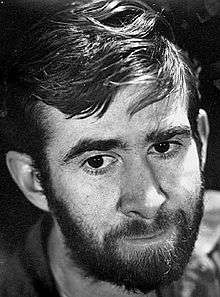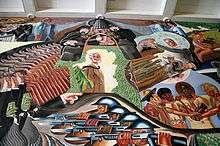Gilbert Brown Wilson
| Gilbert Brown Wilson | |
|---|---|
 | |
| Born |
March 4, 1907 Terre Haute, Indiana |
| Died |
January 16, 1991 (aged 83) Frankfort, Kentucky |
| Nationality |
|
| Education | Indiana State University, Chicago Art Institute, Yale University |
| Known for | painting, murals |
| Movement | social realism |
Gilbert Brown Wilson (1907–1991) was an American painter known for his large-scale murals, including his 1935 murals in Woodrow Wilson Junior High School in Terre Haute, Indiana.[1]
Much of his later life was dedicated to depicting Herman Melville's Moby Dick. In 1955 a short film using this body of artwork won a Silver Reel Award at the Venice Film Festival.[2]
Early life
Wilson was born on March 4, 1907, in Terre Haute to parents Martha, a former opera singer, and Wilton A. Wilson, a banker. An active Boy Scout, he attended McLean Junior High and graduated from Garfield High School in 1925.[3]
Education
Wilson attended Indiana State Normal (now Indiana State University) and studied under professor of art William T. Turman. In 1928 he began instruction at the Chicago Art Institute, where he exhibited at the Hoosier Salon and won two awards, in 1929 and 1930. In Chicago, Wilson met mural painter Eugene Savage, from whom he learned the craft of murals at Yale School of Fine Arts. Wilson became enamored with the work of prominent muralists Diego Rivera and José Orozco and travelled to Mexico to study under Rivera; there he would also study with sculptor Urbici Soler.[3]
Philosophy
Inspired by Rivera, Orozco and Savage, as well as Terre Haute-area thinkers like social activist Eugene Debs and writers Theodore Dreiser and Max Ehrmann,[4] much of Wilson's work concerns the plight of the common man. Common themes in his murals are war, capitalism, industrialization and ecological issues.
Wilson later recalled how seeing Orozco's work for the first time had been a revelation, saying, "From that moment on I knew it was what I wanted Art to be — a real, vital, meaningful expression, full of purpose and intention, having influence and relation to people's daily lives — a part of life. Here was the first modern art I had ever seen."[5]
Wilson did not always find support from his community during his time in Terre Haute, particularly finding conflict with the town's affluent, who found his motifs of oppression and social change unappealing. He dealt with frustration and depression through much of his career, even destroying part of his own mural in Indiana State University's Laboratory School.[4]
Other common themes were multicultural community and racial equality. In 1960 Wilson was artist in residence at Kentucky State College and proposed a set of murals for the gymnasium depicting black history. However, the gymnasium burned down before the murals were undertaken, and Wilson was later fired from his position there for his communist beliefs. His oil painting John Henry, from this time period, was possibly a study for these murals.[6]
Works
Many of his murals can be found in schools and other public places including Antioch College, New York City's School of Sculpture, School of Dance (Columbus, Ohio), the Spink Wawasee Hotel, Chicago's Lincoln Park building and local community theaters in Terre Haute.[4]
Woodrow Wilson Middle School murals

Wilson's first job upon returning to his hometown in 1933 was a set of four murals at Woodrow Wilson Middle School. Called "Liberation", these large-scale chalk murals can be found directly inside the main entrance of the building and took Wilson three years to complete, ending in 1935.[7]
The murals, which span three walls, depict images of industrialization, capitalism, greed, agriculture, warfare and a needy populace. A portion of the mural shows four Boy Scouts of different ethnic backgrounds clasping hands with a quote showing Wilson's "respect and admiration" for scouting.[7]
Upon completion of the murals, the school board refused to pay or reimburse Wilson for his work. His only payment was a collection of coins by the school's students that totalled $28.[3][4]
Partially due to the presence of Wilson's murals, the school is now on the National Register of Historic Places.[8]
Indiana State University
A mural in ISU's University Hall (formerly the Laboratory School) was completed by Wilson in 1936 after six weeks of work. Funded by the Works Progress Administration, themes of the work include an anti-war sentiment coupled with poor stewardship of the earth, Dust Bowl devastation and the necessity for multicultural collaboration. Wilson's own writings about the work state that the mural "is an attempt to state thru the medium of form and color the greatest problem facing civilization today. That problem is WASTE. Waste of the earth upon which we live and the waste of human life."[9]
Wilson's creativity and local sensibility was made all the more evident when artist Bill Wolfe restored the mural in 2009 and realized that Wilson had used clay from the nearby Wabash River in some of his colors.[1]
The university is home to six works by Wilson in all. One visible mural called "They Who Work Humbly" (dated 1932) is in the foyer of Tilson Auditorium. Another work depicting professor Fred Donaghy was lost in 1998 when the Classroom Building where the mural was located was razed.[9]
Antioch College
The Curl Gymnasium of Antioch College's Wellness Center is the home of his eponymous mural, which was dedicated as a class gift by the Antioch College Class of 1938 to the school.[10] Separated into three sections titled "Collapse," "Man Emerges," and "Order," this mural evoked themes such as racial and gender equality, the destructive spread of fascism in Europe, the collapse of modern civilization under capitalism, and the relationship between man and nature.[10] Wilson described in the 1939 Antioch Alumni Bulletin that "in the mural, where I have sought to paint the collapse of modern civilization under capitalism, it is but a picture of what one artist feels is ahead if something is not done."[10]
Moby Dick
After reading Herman Melville's Moby Dick in the late 1940s, Wilson created numerous artworks around the book, which he viewed as a guide for the betterment of humanity. In 1955 a short film using his artwork won a Silver Reel award at the Venice Film Festival. The next year, Wilson traveled with his Moby Dick paintings and drawings on a 27-state tour.[2]
Writings
In addition to his artwork, Wilson was a published writer. In the late 1930s, Wilson had numerous conversations about art, politics and current events with novelist Sherwood Anderson which would become the subject of his piece "A Mural Portrait of Sherwood Anderson."[11] Wilson also published an interview with cartoonist Art Young in the summer 1938 issue of Direction Magazine, including portraits of Young both by Wilson and by José Clemente Orozco.[12]
Legacy
The definitive collection of Wilson's work was bequeathed to the Swope Art Museum in Terre Haute after Wilson's death. A 2007 exhibit Gilbert Wilson, Native Son commemorated the centennial of his birth.[13]
References
- 1 2 Trigg, Lisa (November 2009). "Restoring Anew". Terre Haute Living. Terre Haute, Indiana: Tribune Star. Retrieved December 6, 2010.
- 1 2 "A Singular Vision: Gilbert Wilson and Moby Dick". Wisconsin: Museum of Wisconsin Art. July 27, 2007. Retrieved December 6, 2010.
- 1 2 3 "Gilbert Wilson". Wabash Valley Profiles. Terre Haute, Indiana. March 22, 2001. Retrieved December 7, 2010.
- 1 2 3 4 Beasley, Darla (March 2002). "Gilbert Wilson's Dream of a Hautean Utopia". Cunningham Memorial Library Newsletter. Terre Haute, Indiana: Indiana State University. Retrieved December 7, 2010.
- ↑ Wilson, Gilbert Brown; Baigall and Williams. "A Mural Painter's Conviction". Artists Against War and Fascism. qtd. in Anreus, Alejandro; Diana L. Linden; Jonathan Weinberg (2006). The social and the real: political art of the 1930s in the western hemisphere. Pennsylvania State University. pp. XIII.
- ↑ Swope Art Museum (2009). "African American Images and Artists from the Swope Collection". Wall text. Resource Library. Retrieved December 8, 2010.
- 1 2 Hill, Linda. "Woodrow Wilson Middle School mural". Woodrow Wilson Middle School website. Retrieved 9 December 2010.
- ↑ National Park Service (2009-03-13). "National Register Information System". National Register of Historic Places. National Park Service.
- 1 2 Meyer, Paula (September 1, 2009). "Preserving history: Local artist restoring University Hall's Gilbert Wilson mural". Terre Haute, Indiana: Indiana State University. Retrieved December 8, 2010.
- 1 2 3 "Songs from the Stacks: November 29, 2012". November 29, 2012. Retrieved October 2015. Check date values in:
|access-date=(help) - ↑ Bryer, Jackson R. (1989). Sixteen Modern American Authors. Duke University Press. p. 16. ISBN 0-8223-1018-X.
- ↑ Wilson, Gilbert Brown (1938). "An Appreciation of Art Young" (PDF). Direction (Summer 1938). Retrieved December 8, 2010.
- ↑ "Swope Art Museum Announces Gilbert Wilson Retrospective". Terre Haute, Indiana: Swope Art Museum. Retrieved December 6, 2010.
External links
- Woodrow Wilson Middle School mural: decoding and explaining the various motifs found within
- Woodrow Wilson Middle School: images on Flickr